Fabric dye is the colored substance that enable fibers and materials to be colored. It bonds chemically to the material that it is applied to. This makes fabric dyes different from pigments as pigments don’t chemically bond to the material that they color. Fabric dyes are easily soluble in water whereas pigments are insoluble.
To get a better understanding of what is fabric dye, we need to look at the different kinds of dyes, which are either natural or synthetic (artificial).
Natural Fabric Dye
Natural fabric dyes can be divided into 3: animal, plant or mineral dyes.
Natural fabric dyes are derived from plants, animals and invertebrates or minerals. The sources of natural dyes are roots, nuts, insects, flowers, berries, bark, leaves, wood and other biological sources such as fungi and linchens.
The majority of natural dyes that are used in the fashion industry today, are vegetable dyes that are derived from plant sources.
Without getting too technical about Latin names and the history of each, the natural fabric dyes that are mostly used in the fashion and textile industry are:
1. Animal derived dyes
Animal dyes are extracted from animal or invertebrate bodies.
- Carmine which is extracted from cochineal. Cochineal is a scale insect and red dye is obtained from it.
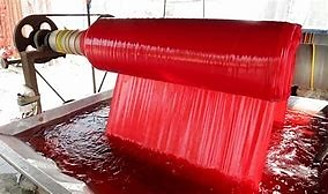 Indian yellow is derived from the urine of cows or cattle.
Indian yellow is derived from the urine of cows or cattle.- The lac insect provides red and violet dyes.
- Purple is derived from murex snails and in ancient times it was known as Tyrian purple. It was regarded as a luxury dyestuff as thousands of snails were needed and it was very labour intensive to extract the dye.
- Crimson is produced from the dried bodies of the kermes insect. It was another ancient dye but the production died out when carmine was discovered as crimson kermes was about 12 times more epensive to produce.
- Sepia brown is obtained from cuttlefish and octopus.
2. Plant derived dyes
Plant or vegetable based dyes are extracted from the roots, stems, leaves, flowers and fruits of plants. Plant based dyes like indigo, saffron, wood and madder were commercially produced and became important in the trade between Europe and Asia.
- Himalayan rhubarb root yields yellow. It is a flowering herb which also has medicinal uses.
- Saffron is derived from the Crocus Sativus flower and produce a rich golden yellow hue to fabrics and dishes.
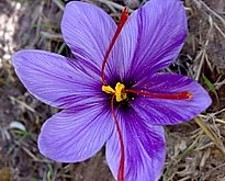 It has been in use for more than three millennia as a dye, seasoning, fragrance and medicine. By weight, it is one of the most expensive spices in the world.
It has been in use for more than three millennia as a dye, seasoning, fragrance and medicine. By weight, it is one of the most expensive spices in the world. - Brown is derived from catechu or the Cutch tree. Catechu is an extract from acacia trees and can be used as a dye, tannin, food additive or an astringent.
- Gamboge tree resin yields a pigment that ranges from a deep saffron to a dark mustard yellow.
- Green, brown, dark brown, crimson and purple are all derived from Mangosteen peel. Mangosteen is an evergreen tropical tree with edible fruit and native to Southeast Asia.
- Blue is derived from the Indigofera plant and the deep indigo blue is extracted from the leaves.
- Kamala tree produces a red dye.
- Alizarin is extracted from the madder root and yields red, pink and orange.
- Yellow is derived from the Larkspur plant, which is a perennial flowering plant which is native to the Northern Hemisphere and the high mountains in tropical Africa.
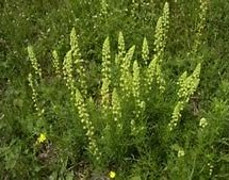
- Weld herb is often classed as a common weed and yellow is derived from it.
- Curcumin (yellow) is extracted from turmeric.
- Teak Leaf produces crimson to maroon. Teak is a deciduous, tropical hardwood tree.
- Yellow, green and black is derived from the Myrobolan fruit, or otherwise known as Indian gooseberry. It is a deciduous tree and has edible fruit.
- Julans Nigra or Black Walnut seed is a deciduous tree grown for it’s wood and also the fruits namely walnuts. Brown and black are derived from the walnut tree and it is also a source of tannin.
- Yellow is derived from Pomegranate Peel. Pomegranate is a fruit bearing deciduous shrub and is commonly found in the Norther Hemisphere. The fruits are used in cooking, baking, alcoholic beverages, juice blends and meal garnishes.
- Rhus typhina or Staghorn Suma tree produces brown and is a source of tannin.
Plants that yield green dye are rare.
3. Mineral dyes
Mineral dyes are not an invention and are often used in the production of carpets. The mineral dyes that are mostly used are:
- Ochre is a kind of iron ore which is an earth mineral oxide. Yellow, red and brown nuances are derived from it.
- Manganese – black nuances are derived from this metallic element.
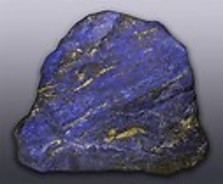
- Malachite – an intense green is derived from this mineral which is a mix of copper carbonate and copper hydroxide.
- Azurite is a blue / dark blue copper mineral and is often found with malachite as they are both products from oxidation and erosion of copper.
- Lapis lazuli is a blue rock which is a mixture of calcite, azurite, pyroxenite and other silicate minerals.
- Cinibar is a reddish heavy mineral which is made from quicksilver sulfide.
- Lead is also used for red.
- Aragonite produces colorless and white nuances.
Synthetic Fabric dye
Synthetic or artificial dyes are manmade and are mainly derived from petro-chemicals through the chemical processing of coal tar (or oil processing). 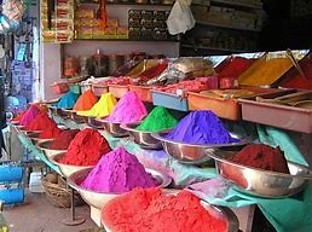 Synthetic dyes were started in the middle of the 19th century and it led to the decline in the production of natural dyes.
Synthetic dyes were started in the middle of the 19th century and it led to the decline in the production of natural dyes.
Mauve or mauveine was the first synthetic dye that was discovered by William Perkin in 1856. It was by pure chance that he discovered it and it quickly led to the discovery of fuchsine, safranine and induline. Many thousands of synthetic dyes are now available.
Synthetic fabric dye can easily be produced in very large quantities and are suitable for the dyeing of synthetic fibers and fabrics. Some chemicals found in synthetic dyes include mercury, lead, copper, benzene, chromium, toluene and sodium chloride. All these can be toxic when an individual is exposed to large doses.
Each synthetic fiber requires it’s own method of dyeing. Nylon requires acid, disperse and pigment dyes, whereas rayon acetate needs disperse dyes.
Natural vs Synthetic Dyes – what are the differences?
One needs to understand the advantages and disadvantages of both natural and synthetic dyes to make an informed choice as to which one is better. Both have advantages and disadvantages, so what are the differences between them? 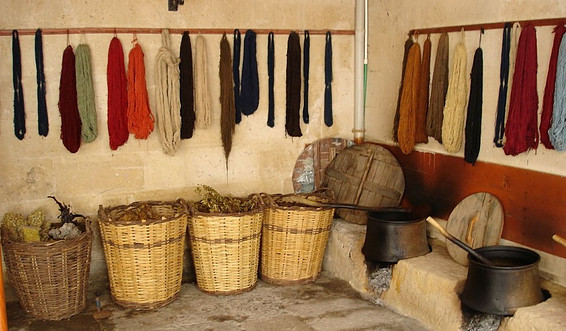
- Intensity and brilliance of the color: Natural dyes are more muted than synthetic dyes. Synthetic dyes often look stark and garish whereas natural dyes are more earthy and subtle. Synthetic dyes have a wider and brighter color range and the color is more permanent. It is because the color is long-lasting and available in a wide range of colors that synthetic dyes quickly became popular.
- Impact on the environment: Natural dyes are less destructive to the environment. In general the synthetic dyes that are used in the textile industry, cause health problems in workers and cause environmental and water pollution.
- Health and wellness of the workers: Chemical compounds are used to manufacture synthetic dyes and fumes are released. These chemical fumes from the dye pots can be toxic and harmful to people, specially those that work on the production line. Sulfuric acid is very potent and can burn the skin. Respiratory problems and lung cancer can develop if proper precautions are not taken when working with the synthetic dyes. On the other hand most natural dyes are safe and harmless although logwood can be toxic.
- Price and cost: Natural dyes are more expensive with cochineal costing more per ounce than gold. Synthetic dyes are cheaper, faster and easier to produce than natural dyes. Over ten thousand different types of synthetic dyes are readily available at a low cost compared to natural dyes.
Personally I think natural fabric dyes are the best as they are less harmful to the environment. Natural fabric dye give the yarn a natural and high lustre which is difficult to achieve with synthetic dyes. I hope this has given you a better understanding of what is fabric dye and the options that are available.
The Process of Dyeing.
The history of dyeing goes back to the Neolithic period and in China dyeing with plants, roots and insects have been traced back more than five thousand years.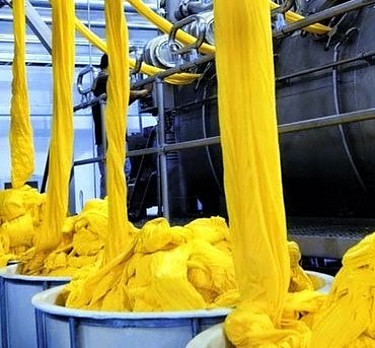
The essential process of dyeing has changed very little over the centuries. Typically, the dye is put into a pot of water and brought up to boiling point. The fiber or yarn that needs to be dyed, is then added to the pot and stirred until the color has been absorbed by the textile. This varies in time from a day to sometimes weeks.
Different processes are used for fiber, yarn and fabric and various treatments are required before and after the dyeing process, but these will be discussed in a separate article.
After the dye has been applied in the water solution, a mordant might be required to fix the fabric dye to the fiber and improve the color fastness of the fabric. Although dyeing can take place before spinning the natural wool or other fibers, many fabrics and textiles are dyed after weaving.
What are Mordants?
One needs to “bind” the color to the fibers or textiles. Mordants such as aluminium, copper, chrome and iron are the substances that are used to “fix” the dye to the fibers or fabrics. But the mordant used to bind the color might be toxic.
In the early days a variety of natural products were used like, salt, tannin from oak galls, natural alum, ammonia from stale urine or vinegar. Nowadays chemicals, known as mordants, are used to bind the fabric dye to the fabric. Many mordants and also some dyes themselves, produce very strong odors and need to be separated from other textile processes.
The type of mordant used can change the colour of the dye solution and also affect the shade of the final product.
Homemade Fabric Dyes
Many years ago when I was weaving, I experimented with dying my own wool. 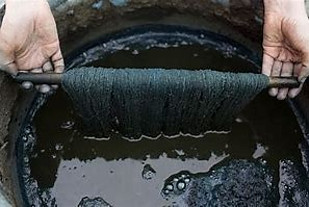 The first batch I tried was using onion skins. I boiled the onion skins in water and then added the natural colored 100% merino wool. It yielded a yellowish hue, bordering on the mustard, much to my surprise. The next batch of course looked different as the intensity of the onion skins and the quantity of water would have been different.
The first batch I tried was using onion skins. I boiled the onion skins in water and then added the natural colored 100% merino wool. It yielded a yellowish hue, bordering on the mustard, much to my surprise. The next batch of course looked different as the intensity of the onion skins and the quantity of water would have been different.
The next color I tried was using carrot peelings, expecting bright orange wool. Once again the color was far more subdued than I had expected. But it was very exciting boiling up the concoction and waiting for the surprise of the color.
To “lock” in the color I then added vinegar to the water and the wool.
What is the current trend?
Since the beginning of the 21st century, there has been a resurgence in the demand for natural fabric dye to be used in the fashion industry. Western consumers have become more and more concerned about the environmental and health impact of synthetic fabric dye in the production of yarns and fabrics. It is leading to a growing market for products that use natural dyes.
More dye manufacturers are focusing on creating dyes that are using environmentally friendly ingredients and minimizing the use of harmful chemicals in their products. So when it comes to what is fabric dye, choose what has the least harmful effect on people, nature and the environment.
Related post: FabricDye: How Eco friendly is it?
Please feel free to leave any comments or questions below and I will get back to you.

I loved this article! Honestly, it’s true there is a lot of pollution in the world, and the fact that they are using this for clothing trends will cause more pollution. I think it’s better to use natural fabrics since a lot of people are getting sick from these dyes I think it’s important for people to understand that just because the clothing trends have those dyes doesn’t mean you have to use them. It’s important to save the environment and the people who are allergic to these fabrics. We have to make difference by using different things to wear not wearing them because there trending, but they have to be ok with the environment and of course, I’m not saying EVERYTHING you own has to be natural, but please make a difference.
The important thing is to make a difference, and the best way is by choosing eco friendly products. All the best.
Fabric dye is not a topic that needs to be difficult or complicated, and it isn’t. So please expand on what you find complicated, and I can explain.
I enjoyed reading your in-depth and very educative article on dyes.
Before reading this post I didn’t know the difference between natural dye and a synthetic one.
I prefer the natural dyes that are earthy and subtle. I have no idea if the Colour Fixer I sometimes use for the washing machine to recolour clothes is a natural one?
To see if the colour fixer that you are using is natural or synthetic, you will have to look if there is any indication on the packaging. Alternatively you can contact the manufacturer and ask them the question.
This is SUCH an informative and well-written article – not to mention just a pleasure to read!
I know people who have animals from which they harvest the wool/fur and spin their own threads to be turned into many different products. Most of them most definitely want to use natural dyes as they are as concerned about the environment as you and I are. This article would be invaluable to them.
Personally, I make cheese and yes, dyes go into that as well. Synthetic dyes look… well, synthetic! Natural dyes make the cheese look natural, not to mention that they are completely organic, natural and safe.
I found it particularly interesting to read about the harmful effects on the workers making synthetic dyes. We all should be thinking of this next time we go to purchase fabric.
Thank you for taking the time to inform us all of this important topic!
Thank you Feochadan, it is always a joy to work with natural products and if you have produced it yourself, even more so. You are welcome to share the article with your friends if you think it would be beneficial for them. And yes, synthetic products so often look artificial
cool topic, I really love your use of visuals to help you explain and it eases and gives more willingness to read.
I would’ve liked seeing a bit of history. the origin of dye, for example why blue was so expensive, etc …
What is fuchsine, safranine and induline ? Would be great if you explained that in your post as not everyone are experts.
Fuchsine, safranine and induline were some of the first synthetic colors that were developed. I intend doing another article on the history and dye processes.
This is actually a very good, well-managed article about the fabric of dye and the entire process of making this kind of fabric. I also like how you categorised the animals, plants and minerals, I didn´t know that they did dye with minerals of plants so this was very helpful information. Thank you.
Most fabrics and yarns are dyed, being it with natural or synthetic dyes
Line, I find myself taking an interest in discussions about natural foods and products because maybe it is all these chemically created things that make us sick. This is very interesting because I have used dye when I used to do my batik creations and when I did my limited amount of painting, but I never even considered their origin, nor the fact that some were natural and some man made. All those plants !!! Thank you for eye opening information.
I personally think it is the amount of chemicals in our lives these days that cause many allergies and sickness. It is indeed interesting to discover all the options and specially the natural fabric dyes that are available.